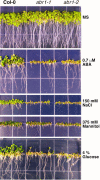ABR1, an APETALA2-domain transcription factor that functions as a repressor of ABA response in Arabidopsis
- PMID: 16227468
- PMCID: PMC1283757
- DOI: 10.1104/pp.105.066324
ABR1, an APETALA2-domain transcription factor that functions as a repressor of ABA response in Arabidopsis
Abstract
The plant hormone abscisic acid (ABA) plays an important role in plant development and stress responses. An important step of ABA action is activation or inactivation of gene expression. Although several transcription factors are identified to function as positive regulators of ABA-induced gene expression, little is known about the negative regulators of ABA-regulated gene expression. Here, we have identified an APETALA2 (AP2) domain transcription factor that serves as a repressor of ABA response during seed germination and ABA- and stress-induced gene expression in Arabidopsis (Arabidopsis thaliana). The expression of the AP2-like ABA repressor 1 (ABR1) gene itself was responsive to ABA and stress conditions including cold, high salt, and drought. Disruption of ABR1 led to hypersensitive response to ABA in seed germination and root growth assays. The mutant plants were also hypersensitive to osmotic stress conditions, such as high salt and high concentrations of mannitol. Further analyses indicated that increased stress sensitivity may result from hypersensitivity to ABA as ABA biosynthesis inhibitor rescued the stress hypersensitivity phenotype. The abr1 mutant plants accumulated significantly higher levels of ABA- and stress-inducible gene transcripts as compared to the wild-type plants, supporting the hypothesis that this AP2 domain protein serves as a repressor of ABA-regulated gene expression.
Figures








References
Publication types
MeSH terms
Substances
Associated data
- Actions
LinkOut - more resources
Full Text Sources
Other Literature Sources
Molecular Biology Databases
Research Materials

